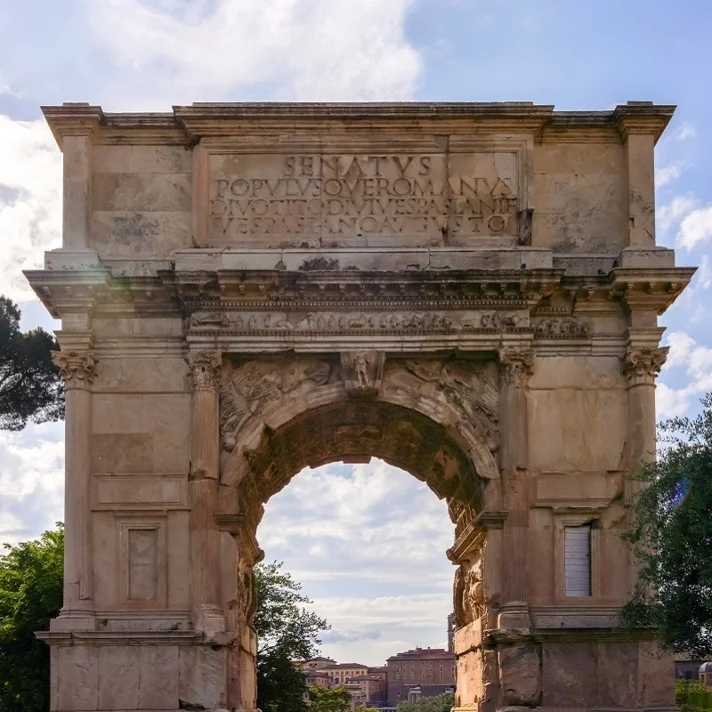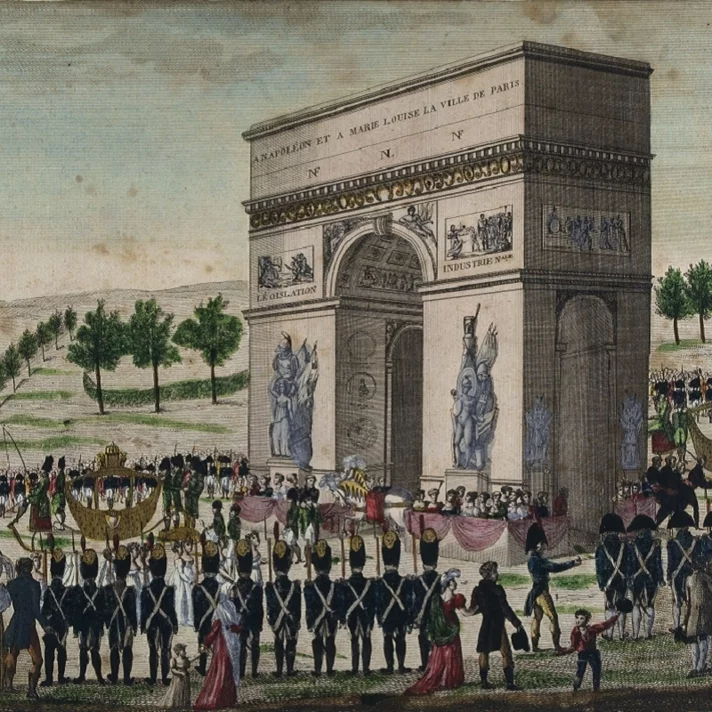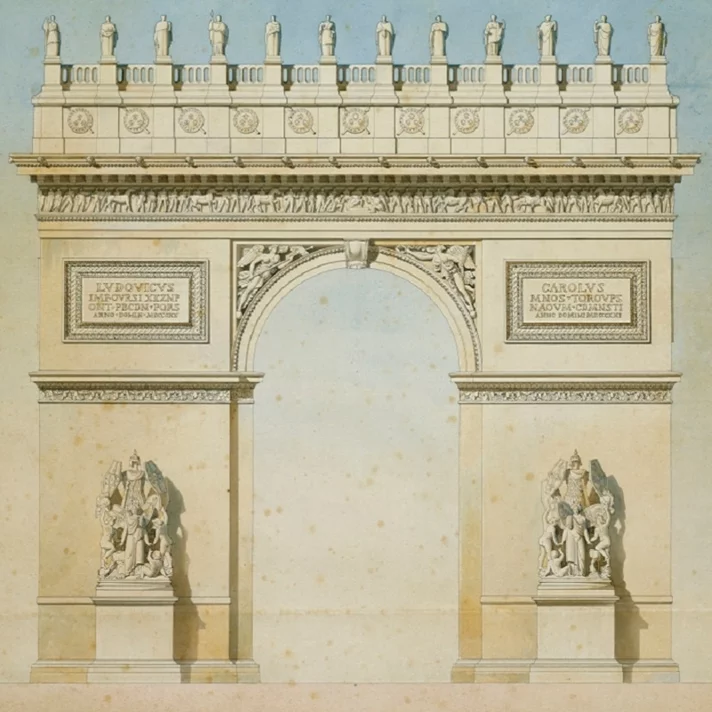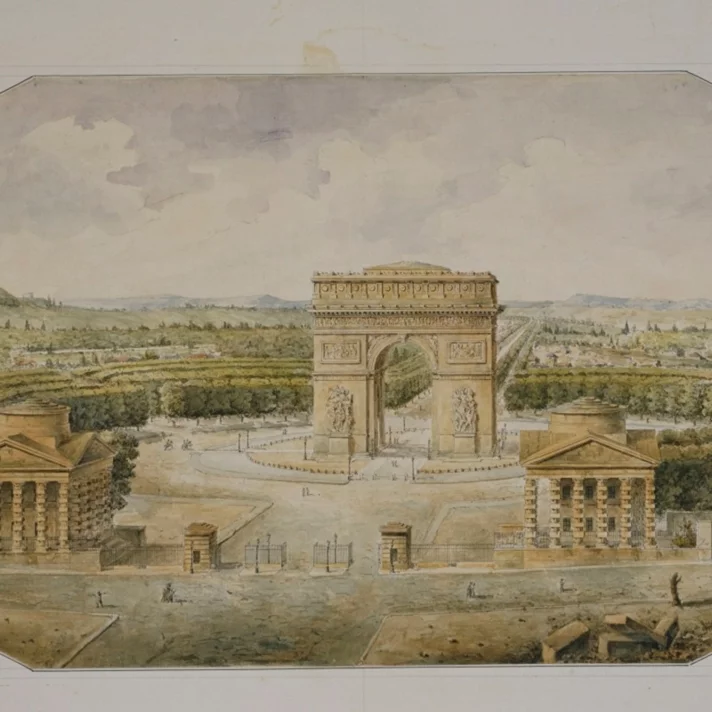History
article | Reading time8 min
History
article | Reading time8 min
Go through the fascinating history of the Arc de triomphe through a historical and political construction site and find here the main stages of its construction, from 1806 to 1836!
Once they had designated the Place de l'Étoile as the site for the Arc de triomphe, architects Jean-François Thérèse Chalgrin and Jean-Arnaud Raymond drew up a series of plans. In particular, they opted for an arch with a simple opening, since it would also serve as a gateway to the city.
This architectural bias makes direct reference to ancient arches such as the Arch of Titus in Rome (85 AD). Among the many sources of inspiration for the two architects, we can also identify the Arch of Saint-Denis built by Blondel or the Arch of Constantine in Rome (315 AD) for Attica and the Corinthian order.
© ThePhotografer
On April 2, 1810, Napoleon I married Marie-Louise of Austria. The imperial couple left the Palace of Saint-Cloud where the civil wedding had taken place the day before to reach the Louvre Palace to celebrate their religious wedding.
The itinerary included entering Paris through the Place de l'Étoile. At the time, the construction of the Arc de triomphe was not completed. The base of the four pillars was barely above ground. It was then decided to build a life-size model. Chalgrin ordered from Louis Laffitte an arch of painted frames and canvas and five hundred workers were hired to meet the deadline. The carpenters then began a strike to denounce the working conditions and the low wages. While the Prefect of Police had six of them arrested, the others saw their wages increase from 4 francs per working day to 24 francs per working day.
The total cost of the temporary construction amounted to 511,000 francs, but it allowed the architect Chalgrin to make changes to his plans, particularly to add projections, the removal of the pedestals, as well as the choice of ornamentation for the fronts.
On January 20, 1811, Chalgrin died while the pillars of the Arc de triomphe were only a dozen meters high, that is to say, at the level of the bases of the vault of the great arch. Louis-Robert Goust, his student, succeeded him at the helm of the project.
Reproduction Patrick Cadet / Centre des monuments nationaux
After the fall of Napoleon and the arrival in power of Louis XVIII, the construction of the Arc de triomphe was suspended. In 1814, the architect Bernard Poyet proposed to raze the existing pillars. Louis XVIII refuses although he does not express any will to resume the construction. This project, ordered by Napoleon, did not find favor with the monarchists. Many proposals were made between 1814 and 1823, but none of them caught the king's attention.
On October 9, 1823, Louis XVIII instituted that the Arc de triomphe should be finished immediately but with a new dedication. The king decided, in fact, to celebrate not the imperial army but the Army of the Pyrenees. Led by Louis Antoine de Bourbon, Duke of Angouleme and nephew of Louis XVIII, the Army of the Pyrenees had just reinstated the king of Spain (Ferdinand VII) to his throne. The kingdom of France claimed this victory as its.
Construction gradually resumed, and Louis-Robert Goust was associated with another architect: Jean-Nicolas Huyot. Both of them took over Chalgrin's plans and were in charge of reworking them to add columns to the fronts. Louis XVIII died on September 16, 1824, and was succeeded by his brother Charles X.
© Reproduction Patrick Cadet / Centre des monuments nationaux
Charles X continued construction on the monument following the wishes of Louis XVIII. In 1825 Huyot was dismissed following his proposal for columns on the fronts, while Goust remained in place. Huyot was not reinstated until 1826. Charles X decided that Chalgrin's plans should be respected. The same year, a commission of architects met and discussed the ornaments to be made. It was decided that the vault would be decorated with 21 caissons with rosettes, that paintings in high relief would be sculpted on the fronts, and that Chérence stone (Vexin) would be used to create the sculptures of the entablature.
In 1828, the monument was raised to the architrave of the entablature. On July 29, 1829, a marble plaque was installed on one of the pedestals. It represents the new dedication to the Army of the Pyrenees. In 1830, Goust withdrew from the project, leaving Huyot alone. Huyot submitted to Charles X a project to decorate the upper cornice with 36 statues symbolizing the major cities of France.
On August 2, 1830, the French people rose up against the king. More than 20 000 men gathered around the Arc de triomphe. Commanded by General Pujol, this army of patriots demanded the abdication of Charles X, which he signed from the château de Rambouillet.
© Reproduction Patrick Cadet / Centre des monuments nationaux
A new political period began after the revolutionary days of July 1830, also called the Trois Glorieuses. Louis-Philippe I ascended the throne and unlike his predecessors, he intended to reign in a spirit of concord and presented himself as King of the French.
The construction of the Arc de triomphe, which had stopped once again, does not seem ready to resume... The situation seems all the more critical as the financial credits were exceeded by Huyot. On July 31, 1832, Louis-Philippe appointed Guillaume Abel Blouet to complete the Arc de triomphe with a new dedication to the Armies of the Revolution and the Empire.
At the same time, Adolphe Thiers, then Minister of the Interior, placed an order with several sculptors to create the allegorical decorations. Thus, artists Cortot, Etex, Rude, Lemaire, Seurre, Feuchère, Chaponnière, Gechter, Marochietti, Pradier, Bra, Valois, De Bay, Jacquot and Laitie were all mobilised to realise the high reliefs, the frieses, the spandrels, the shields and the balustrade of the monument.
On February 20, 1836, Lieutenant General Saint-Cyr Nugues proposed three lists of names: 30 decisive battles of the Revolution and the Empire for the attic, 96 feats of arms and 384 generals to decorate the pedestals.
© Reproduction Philippe Berthé / Centre des monuments nationaux
On July 29, 1836, after 30 years of construction, the Arc de triomphe was finally inaugurated. The lists of names on the pedestals were unveiled. However the great celebration that was supposed to take place was cancelled for fear of an attack against king Louis-Philippe. Only eleven people were present: the president of the Council of Ministers Adolphe Thiers, the Minister of Finance Antoine Maurice Appolinaire Argout, six national guards, the guardian of the monument, and two official visitors.
At nightfall, a crowd gathered in front of the Arc de triomphe which was illuminated by 700 gaslights. Afterwards, the government and the architect faced a wave of protest regarding the names inscribed on the pillars. It was assured that all the requests were studied and that Blouet would immediately add 128 names of generals and 172 forgotten battles. In his work published in 1837 and entitled Les Voix Intérieures, Victor Hugo lamented the fact that his father, Jospeh-Léopold-Sigisbert Hugo, who had been appointed General by Louis XVIII in 1814, was not included.
Subsequently, additions were made from time to time until 1895.
© Reproduction Thomas Thibaut / Centre des monuments nationaux
If you want to go back in detail on these men who made the Arc de Triomphe, we invite you to enter the history of this masterpiece of neo-classical architecture in pictures.









